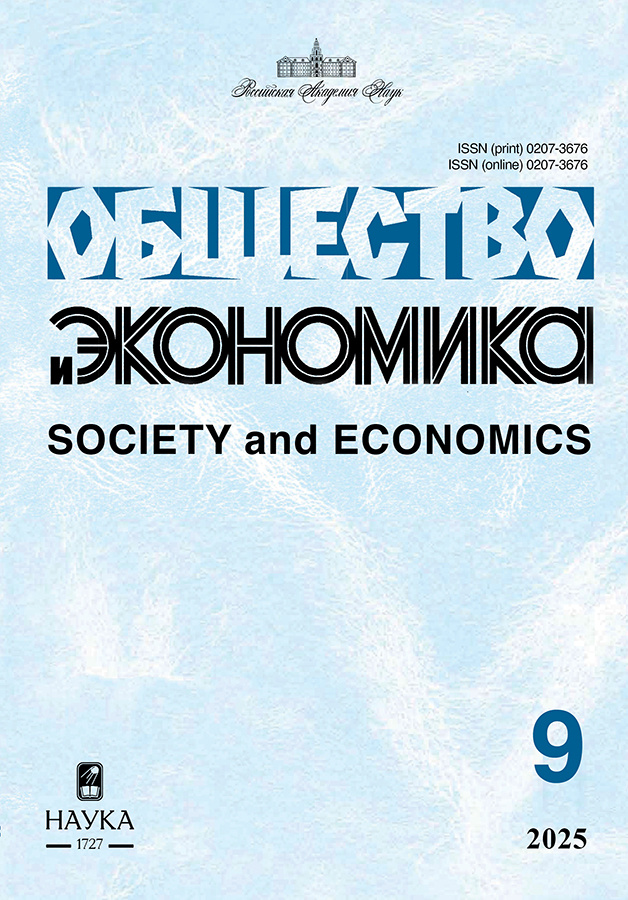Неприменимость общеэкономических подходов к отстающим странам
- Авторы: Князев Ю.1
-
Учреждения:
- ФГБУН Институт экономики РАН
- Выпуск: № 2 (2024)
- Страницы: 26-40
- Раздел: ВОПРОСЫ ЭКОНОМИЧЕСКОЙ ПОЛИТИКИ
- URL: https://ter-arkhiv.ru/0207-3676/article/view/673795
- DOI: https://doi.org/10.31857/S0207367624020021
- ID: 673795
Цитировать
Полный текст
Аннотация
В мире в течение столетий наблюдается большой разрыв в уровне экономической развитости между странами «золотого миллиарда» и остальной частью земли, где за исключением отдельных государств (Китая, «азиатских тигров», некоторых других стран) имеет место стагнация и даже деградация хозяйственной активности и уровня жизни населения. Цель статьи состоит в доказательстве ограниченной возможности применения к отстающим странам, в том числе постсоциалистическим государствам, включая Россию, многих теоретических подходов и предлагаемых практических рецептов, которые не соответствуют экономическим реалиям, обусловленным их неблагоприятным положением в глобализирующемся мире. Исследуются причины экономического отставания этих стран, влияние разных факторов на их развитие и условия, определяющие их стагнацию; критически оцениваются некоторые предлагаемые рецепты выхода из отсталости. Обосновывается неприемлемость для современной России некоторых постулатов ортодоксальной экономической теории. Автор излагает свое видение путей преодоления экономической отсталости и рассматривает потенциальные возможности ускоренного роста российской экономики.
Полный текст
Об авторах
Юрий Князев
ФГБУН Институт экономики РАН
Автор, ответственный за переписку.
Email: kyuk151@rambler.ru
доктор экономических наук, профессор, главный научный сотрудник
Россия, МоскваСписок литературы
- Голикова В.В., Гончар К.Р., Кузнецов Б.В., Яковлев А.А. Российская промышленность на перепутье. Что мешает нашим фирмам стать конкурентоспособными. М.: Изд. дом ВШЭ. 2007.
- Гэмбл Эндрю. Кризис без конца? Крах западного процветания. М.: Издательский дом ВШЭ. 2018. 304 с.
- Жданова Л.Л. Дискуссионные вопросы теории воспроизводства и накопления капитала // Журнал экономической теории. 2019. Т. 16. № 1.
- Кадочников П., Кнобель А., Синельников-Мурылев С. Открытость российской экономики как источник экономического роста // Вопросы экономики. 2016. № 12. С. 26–42.
- Катуков Д.Д., Малыгин В.Е., Смородинская Н.В. Фактор созидательного разрушения в современных моделях и политике экономического роста // Вопросы экономики. 2019. № 7. С. 95–118.
- Князев Ю. Научный и идеологический аспекты социальных теорий (на примере марксизма) // Экономист. 2019. № 12. С. 65–72.
- Князев Ю. Объективный рынок и сознательное целеполагание // Общество и экономика. 2017. № 7. С. 5–20.
- Любимов И.Л. От универсализма к индивидуализму: новые подходы к решению проблем экономического роста // Вопросы экономики. 2019. № 11. C. 108–126.
- Полтерович В.М. К общей теории социально-экономического развития. Часть 1. География, институты или культура // Вопросы экономики. 2018. № 11. С. 5–26.
- Полтерович В., Попов В. Эволюционная теория экономического развития. Часть I. Опыт быстрого развития. Часть II. Необходимость своевременного переключения // Вопросы экономики. 2006. № 7. С. 4–23; № 8. С. 46–64.
- Сакс Дж. Цена цивилизации. М.: Издательство Института Гайдара. 2012.
- Сидорович А. Новая экономическая политика развития: от системных противоречий к системным решениям // Общество и экономика. 2016. № 6.
- Симачев Ю.В., Данильцев А.В., Федюнина А.А., Глазатова М.К., Кузык М.К., Зудин Н.Н. Россия в меняющихся условиях мировой торговли: структурный взгляд на новое позиционирование // Вопросы экономики. 2019. № 8. С. 5–29.
- Шейнис В. Загадочный облик будущего мира // Мир перемен. 2019. № 3. С. 87–103.
- Шумпетер Й. Теория экономической деятельности. М. 1996.
- Aghion P., Akcigit U., Howitt P. (2015). The shumpeterian growth paradigm. //Annual Review of Economics, Vol. 7. Nо 1. P. 557–575.
- Aghion P., Howitt P. The Economics of growth. Cambridge, MA: MIT Press. 2008.
- Aghion P., Roulet A. Growth and the Smart State // Annual Review of Economics. 2014. Vol. 6. No 1. P. 913–926.
- Acemoglu D., Johnson S., Gallego F., Robinson J. Institutions, human capital, and development// Annual Review of Economics. 2014. Vol. 6. No 1. P. 875–912.
- EBRD. Transition report 2017–2018: Sustaining growth? London: European Bank for Reconstruction and Development. 2017.
- Gereffi G. Global value chain analysis. Center of Globalization, Governance & Competitiveness, Duke University, Durham, North Carolina. 2016.
- Gurvich E. Institutional constraints and economic development // Russian Journal of Economics. 2016. Vol. 2. Nо 4. Р. 349–374.
- Hsieh C.-T, Klenow P.G. Misallocation and manufacturing TFP in China and India // Quarterly Journal of Economics. 2009. Vol. 124. Nо 4. P. 1403–1448.
- Krueger A. Trade policy and economic development: How we learn? //American Economic Review. 1997. Vol. 87. No 1. P. 1–22.
- Kuznetsov Y., Sabel C. New open economy industrial policy: Making choices without picking winners. In: M. Dutz et al, (ed), Making innovation policy work: Learning from experimentation, Washington, D C: World Bank; Paris: OECD Publishing. 2014. P. 35–47.
- Romer P. Endogenous Technological Change // Journal of Political Economy. 1990. Vol. 98. No 5. P. 71–102.
- Rodrik D. Premature deindustrialization // Journal of Economic Growth. 2016. Vol. 21. № 1. P. 1–33.
- Schumpeter J.A. Capitalism, socialism, and democracy. New York: Harper & Brothers. 1942.
- Syverson C. Market structure and productivity: A concrete example // Journal of Political Economy. 2004. Vol. 112. № 6. P. 1181–1222.
- UNIDO. Industrial development report 2018, Demand for manufacturing: driving inclusive and sustainable industrial development. Vienna. 2017.
- World Bank Group. Global value chain development report 2017. Measuring and analyzing the impact of GVCs on economic development. Washington, DC: The World Bank Publications. 2017.
Дополнительные файлы











